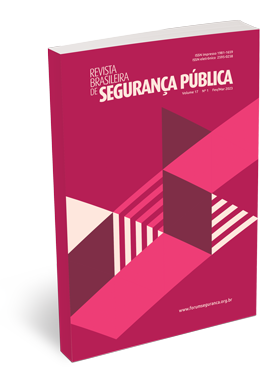Análise temporal de roubos e furtos a residência em Cuiabá, Brasil
DOI:
https://doi.org/10.31060/rbsp.2023.v17.n1.1456Palavras-chave:
Roubo e furto à residência, Padrões temporais, Teoria da atividade rotineira, Teoria da escolha racional, Prevenção criminalResumo
O presente estudo analisa a influência dos fatores temporais na dinâmica dos crimes de roubo e furto à residência no município de Cuiabá/MT. Para isso, toma como base teórica e estrutura de orientação as teorias da atividade rotineira e da escolha racional. Apesar de analisar a distribuição de tais crimes por ano, mês, estação do ano, dia da semana e período do dia, os resultados estatísticos apenas apontam que os roubos são mais concentrados no período noturno. Todavia, a pesquisa indica que os crimes de roubo e furto à residência possuem padrões temporais específicos, o que é de grande importância para embasar as políticas de segurança pública na cidade, as quais deverão adotar, por exemplo, variadas estratégias de prevenção para diferentes períodos do dia e do ano.
Downloads
Referências
ANDRESEN, M. A. The place of environmental criminology within criminological thought. In: ANDRESEN, M. A.; BRANTINGHAM, P. J.; KINNEY, J. B. (Eds.). Classics in environmental criminology, p. 05-28. 2010.
BECKER, G. S. Crime and punishment: An economic approach. In: BECKER, G. S.; LANDES, W. M. (Eds.). Essays in the Economics of Crime and Punishment, p. 01-54. 1974.
BLOCK, R.; GALARY, A.; BRICE, D. The Journey to crime: Victims and offenders converge in violent index offences in Chicago. Security Journal, v. 20, p. 123-137, 2007. DOI: https://doi.org/10.1057/ palgrave.sj.8350030.
BRANDÃO, D. Q.; HEINECK, L. F. M. Significado multidimensional e dinâmico do morar: compreendendo as modificações na fase de uso e propondo flexibilidade nas habitações sociais. Ambiente Construído, v. 3, n. 4, p. 35-48, 2003.
BRASIL. Decreto-Lei No 2.848, de 7 de dezembro de 1940. Código Penal. Diário Oficial da União, 31/12/1940.
CALDEIRA, T. P. R. Cidade de muros: Crime, segregação e cidadania em São Paulo. 2 ed. São Paulo: Edusp, 2000.
CECCATO, V. Homicide in São Paulo, Brazil: Assessing spatial-temporal and weather variations. Journal of Environmental Psychology, v. 25, n. 3, p. 307-321, 2005.
CERVANTES, C.; SÁ, B. Facção CV proíbe roubos em bairros da Capital e espanca quem desobedece. RD News, Polícia, 28 jun. 2017.
COHEN, L. E.; FELSON, M. Social change and crime rate trends: A routine activity approach. American Sociological Review, v. 44, n. 4, p. 588-608, ago. 1979.
COHN, E. G.; ROTTON, J. Weather, seasonal trends and property crimes in Minneapolis, 1987-1988. A moderator-variable time-series analysis of routine activities. Journal of Environmental Psychology, v. 20, n. 3, p. 257-272, set. 2000.
COHN, E. G.; ROTTON, J. Even criminals take a holiday: Instrumental and expressive crimes on major and minor holidays. Journal of Criminal Justice, v. 31, n. 4, p. 351-360, jul.-ago. 2003. DOI: https://doi.org/10.1016/S0047-2352(03)00029-1.
CORNISH, D. B.; CLARKE, R. V. The rational choice perspective. In: WORTLEY, R.; TOWNSLEY, M. (Eds.). Environmental criminology and crime analysis, p. 29-61. 2 ed. London: Routledge, 2016.
COUPE, T.; BLAKE, L. Daylight and darkness targeting strategies and the risks of being seen at residential burglaries. Criminology, v. 44, n. 2, p. 431-464, maio 2006. DOI: https://doi.org/10.1111/j.1745- 9125.2006.00054.x.
CROMWELL, P. F.; OLSON, J. N.; AVARY, D. W. Breaking and entering: An ethnographic analysis of burglary. Newbury Park: Sage, 1991.
CRUZ, S. H. da; AZEVEDO, M. R.; GONCALVES, H. Vitimização por violência urbana em uma cidade de médio porte do sul do Brasil. Revista Brasileira de Epidemiologia, v. 14, n. 1, p. 15-26, mar. 2011. DOI: https://doi.org/10.1590/S1415-790X2011000100002.
FARRELL, G.; PEASE, K. Crime seasonality: Domestic disputes and residential burglary in Merseyside 1988- 90. British Journal of Criminology, v. 34, n. 4, p. 487-498, 1994. DOI: https://doi.org/10.1093/ oxfordjournals.bjc.a048449.
FOX, B. H.; FARRINGTON, D. P. Creating burglary profiles using latent class analysis: A new approach to offender profiling. Criminal Justice and Behavior, v. 39, n. 12, p. 1582-1611, out. 2012. DOI: https://doi.org/10.1177/0093854812457921.
HAMILTON-SMITH, N.; KENT, A. The prevention of domestic burglary. In: TILLEY, N. (Ed.). Handbook of crime prevention and community safety, p. 417-457. London: Routledge, 2005.
HANLEY, R. Burglaries troubles New York suburbs. The New York Times, 19 jan. 1981.
IBGE – INSTITUTO BRASILEIRO DE GEOGRAFIA E ESTATÍSTICA. Cidades e Estados. Cuiabá. 2020.
INSPER. Relatório da pesquisa de vitimização em São Paulo - 2018. Centro de Políticas Públicas, Insper, set. 2018.
JACOBS, J. Morte e vida de grandes cidades. São Paulo: Martins Fontes, 2000.
LAKATOS, E. M.; MARCONI, M. de A. Fundamentos de metodologia científica. 5 ed. São Paulo: Atlas, 2003.
LAURITSEN, J. L.; WHITE, N. Seasonal Patterns in Criminal Victimization Trends. Special Report U. S. Department of Justice, jun. 2014.
LOPES, M. M.; CASTELO BRANCO, V. T. F.; SOARES, J. B. Utilização dos testes estatísticos de Kologorovv- Smirnov e Shapiro-Wilk para verificação da normalidade para materiais de pavimentação. Revista Transporte, v. 21, n. 1, p. 56-59, 2013.
MADALOZZO, R.; FURTADO, G. M. Um estudo sobre a vitimização para a cidade de São Paulo. Revista de Economia Política, v. 31, n. 1, p. 160-180, mar. 2011.
MAGUIRE, M.; WRIGHT, R.; BENNETT, T. Domestic burglary. In: BROOKMAN, F.; MAGUIRE, M.; PIERPOINT, H.; BENNETT, T. (Eds.). Handbook on crime, p. 3-25. London: Routledge, 2010.
MATO GROSSO. Boletim de acompanhamento anual dos crimes contra o patrimônio em Cuiabá, Mato Grosso, 2019.
MCDOWALL, D.; LOFTIN, C.; PATE, M. Seasonal cycles in crime, and their variability. Journal of Quantitative Criminology, v. 28, p. 389-410, set. 2012. DOI: https://doi.org/10.1007/s10940-011-9145-7.
MELO, S. N.; PEREIRA, D. V. S.; ANDRESEN, M. A.; MATIAS, L. F. Spatial/temporal variations of crime: A routine activity theory perspective. International Journal of Offender Therapy and Comparative Criminology, v. 62, n. 7, p. 1967-1991, 2018. DOI: https://doi.org/10.1177/0306624X17703654.
MONTOYA, L.; JUNGER, M.; ONGENA, Y. The relation between residential property and its surroundings and day- and night- time residential burglary. Environment and Behavior, 48, n. 4, p. 515-549, 2016. DOI: http://doi.org/10.1177/0013916514551047.
NASAR, J. L. Environmental factors and commercial burglary. Journal of Environmental Systems, v. 11, n. 1, p. 49-56, 1981.
NEWMAN, O. Defensible space. New York: Macmillan, 1972.
PAIXÃO, L. A. R. O impacto da violência no preço dos imóveis comerciais de Belo Horizonte: Uma abordagem hedônica. Economia Aplicada, v. 13, n. 1, p. 125-152, mar. 2009.
QUETELET, A. A treatise on man and the development of his faculties. Edinburgh: Chambers, 1842.
RENGERT, G. F.; WASILCHICK, J. The use of space in burglary. In: ANDRESEN, M. A.; BRANTINGHAM, P. J.; KINNEY, J. B. (Eds.). Classics in environmental criminology, p. 257-272. 2010.
SANDERS, A. N.; KUHNS, J. B.; BLEVINS, K. R. Exploring and Understanding Differences Between Deliberate and Impulsive Male and Female Burglars. Crime & Delinquency, v. 63, n. 12, p. 1547-1571, 2017. DOI: https://doi.org/10.1177/0011128716660519.
SANTOS, F. M. M.; NOGUEIRA, M. C. J. A. Análise da influência da ocupação do solo na variação termo- higrométrica por meio de transectos noturnos em Cuiabá-MT. Revista Caminhos de Geografia, v. 13, n. 41, p.187-194, mar. 2012.
SENASP – SECRETARIA NACIONAL DE SEGURANÇA PÚBLICA. Pesquisa Nacional de Vitimização. Questionário SENASP. Senasp; Datafolha; Crisp, 2013.
SHOVER, N. Burglary. Crime and Justice, v. 14, p. 73-113, 1991.
SOUZA, F. ‘Quem for pego roubando será punido severamente’: o cartaz anticrime atribuído ao Comando Vermelho. BBC News Brasil, 23 ago. 2016.
TOWNSLEY, M.; BIRKS, D.; BERNASCO, W.; RUITER, S.; JOHNSON, S. D.; WHITE, G.; BAUM, S. Burglar target selection: A cross-national comparison. Journal of Research in Crime and Delinquency, v. 52, n. 1, p. 3-31, jul. 2014. DOI: https://doi.org/10.1177/0022427814541447
TRIOLA, M. F. Introdução à estatística. 10 ed. Rio de Janeiro: LTC, 2008.
VITO, G. F.; MAAHS, J. R.; HOLMES, R. M. Criminology: Theory, Research, and Policy. Sudbury: Jones & Bartlett Publishers, 2006.
XIAO, L.; LIU, L.; SONG, G.; RUITER, S.; ZHOU, S. Journey-to-crime distances of residential burglars in China disentangled: Origin and destination effects. ISPRS – International Journal of Geo-Information, v. 7, n. 8, 2018. DOI: https://doi.org/10.3390/ijgi7080325.
WHEELER, A. The Moving home effect: A quasi experiment assessing effect of home location on the offence location. Journal of Quantitative Criminology, v. 28, p. 587-606, 2012. DOI: https://doi.org/10.1007/s10940-011-9161-7.
WILLIS, G. A. N. The killing consensus: homicide detectives, police that kill and organized crime in São Paulo, Brazil. Tese (Doutorado em Estudos Urbanos e Regionais) – MIT – Massachusetts Institute of Technology, Department of Urban Studies and Plainning, Massachusetts, EUA, 2013.
WORTLEY, R.; TILLEY, N. Theories for situational and environmental crime prevention. In: BRUINSMA, G. J. N.; WEISBURD, D. (Eds.). Encyclopedia of criminology and criminal justice. New York: Springer, 2014.
WRIGHT, R.; DECKER, S. Burglars on the job: Streetlife and residential break-ins. Boston: Northeastern University Press, 1994.
Publicado
Como Citar
Edição
Seção
Licença
Copyright (c) 2023 Revista Brasileira de Segurança Pública

Este trabalho está licenciado sob uma licença Creative Commons Attribution 4.0 International License.
Licenciamento
A Revista Brasileira de Segurança Pública usa a Licença Creative Commons como forma de licenciamento para suas obras publicadas. A licença utilizada segue o modelo CC BY 4.0 - Attribution 4.0 International.
Para consultar os dirietos permitidos direcione-se para a licença completa ou para a nossa página de Direitos dos autores e Licenças.



